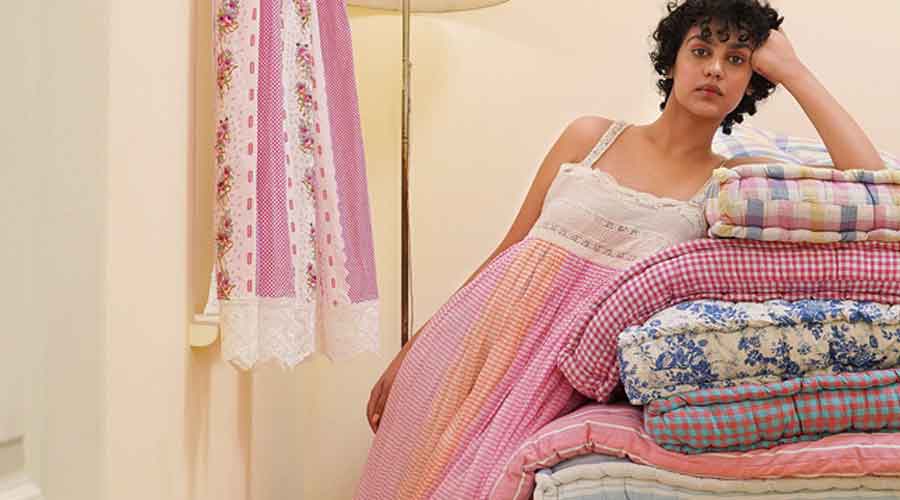The year is 2020 and if you’re even reasonably inclined towards anything sartorial, chances are that you have been hearing about “sustainable fashion”. But as the turn of the new decade has turned everything upside down, time is nigh for the evolution of sustainable, ethical fashion in order to truly facilitate an industry that operates consciously. As per the Indian Brand Equity Foundation, India’s textiles industry has around “4.5 crore employed workers, including 35.22 lakh handloom workers”, while our domestic textiles and apparel market stood at an estimated “$100 billion in FY19”. If nothing at all, the pandemic has acted for most in this business as a catalyst to finally make certain changes to ensure that the entire liability of the economic slowdown is not passed down to the lowest rungs of the ladder. Apart from designers going digital and focusing more on quality than quantity, the recently concluded digital Lakme Fashion Week 2020 also went season-fluid and hosted a two-day line-up to showcase within the purview of sustainability.
So far, the awareness about sustainability ran the risk of being limited to niche circles who preferred their boxy silhouettes and anti-fit ensembles. Recent times, however, have aided the diversification of this notion with a renewed vigour towards the climate, our crafts and a general sense of awareness about why slow fashion can often come at a price higher than its faster counterpart. People are warming up to the idea of paying this premium as designers and their marketeers are bringing the human face of their creations to the fore.
Now, designers have also been diversifying by making more accessible clothing, often in the form of pret, separates, simplistic silhouettes and styles. At LFW, Abraham & Thakore showed a contemporary take on the age-old technique of block-printing; Rajesh Pratap Singh for Satya Paul showed double-ikat saris made by artisans in Telangana; and Gaurang Shah showcased a collection of gorgeous handwoven saris in the form of Taramati. Pankaj & Nidhi focused on their collaboration using futuristic fabrics made of recycled waste, while Urvashi Kaur and Aneeth Arora talked about the importance of having a consistent supply and demand chain to ensure sustainability of business. We try to look at the evolution of ethical fashion through their eyes.
Aneeth Arora

Aneeth Arora Picture courtesy: LFW
Tell us about what you showcasedat LFW and your inspiration behind it..
For Pero, we showcased a film called Locked in Life that shows nine girls confined in their spaces — very much how we were during the lockdown. We took inspiration from the Japanese street culture of Harajuku and looked at its subtle and cute side with a lot of laces, frills and flounces, bows and ribbons, and pinks and pastels. Keeping to the philosophy of the brand, we have incorporated the traditional handmade Indian textiles from various regions like silks from the South, cottons from Bengal and chanderis from Madhya Pradesh.
What about sustainability are you most passionate about?
It’s the continuous flow of work that is the most important aspect of sustainability for us. Therefore, when the lockdown ended, we ensured work for our craftspeople by working on the next season as we hoped that if we produced in time, it would sustain us.
What is the biggest struggle you face while putting sustainability at the forefront in India?
The biggest thing we have realised is that we had tried to interfere in the lifestyle of the craftspeople, which started reflecting in their work. We learnt it the hard way and started working according to their timelines so that we did not put unnecessary pressure on them.
Any thoughts on addressing problems regarding supply chain, cost of raw materials, transport, accessibility and price points?
Earlier, I used to think that it’s the middlemen who caused the prices to rise but, with time, we have realised that all the people involved in the chain play an important role and they get their share, which, in turn, gives us the raw material or the product that is up to the mark. So, these people are integral to the quality of the product we make and the prices that the craftspeople demand should not be negotiated with so much that the middlemen get the biggest share. So we like to keep the process very transparent and ensure we know how much the craftspeople are getting. Having worked for 10 years now, I think we have cracked an ethical code of ensuring we pay everyone their dues.
What is the key to balancing the business aspect of sustainable fashion according to you?
Balance can only be created by putting in an effort to market and sell the products that we are creating, which, in turn, can ensure demand and that is what keeps us going.
How do you envisage sustainability in fashion in India in the next five years?
With more and more designers looking at Indian craft and textiles, sustainable fashion will help revive the craft culture of India, which was almost on the verge of extinction. It will also make the wearer more and more aware of what they are wearing.
Abraham and Thakore

Abraham and Thakore Picture courtesy: LFW
Tell us about what you showcased at LFW and your inspiration behind it...
We have created a capsule collection of block-printed garments, which sheds light on how craft and fashion are interlinked. The collection focuses on the craft of hand-block printing and explores the many ways in which this special hand technique creates unusual and unique textiles. Playing with dots of different sizes and fine lines on a colour palette of sand and gold, this collection of separates focuses on elegant but relaxed dressing.
From a beige and gold studded sari worn with a Victorian-inspired high-neck ruffled blouse, to a gold dotted kedia jacket worn over a tunic and trouser ensemble, and a ruffled maxi skirt worn with a bare-shouldered top, the collection explores modern fashion shapes using an ancient and traditional textile technique.
What about sustainability are you most passionate about?
Sustainability of traditional livelihoods and the preservation of India’s textile craft traditions are very important to us.
What is the biggest struggle you face while putting sustainability at the forefront in India?
The sense of awareness among consumers that every purchase they make has the potential to make a positive (or a negative) difference and that they should buy wisely.
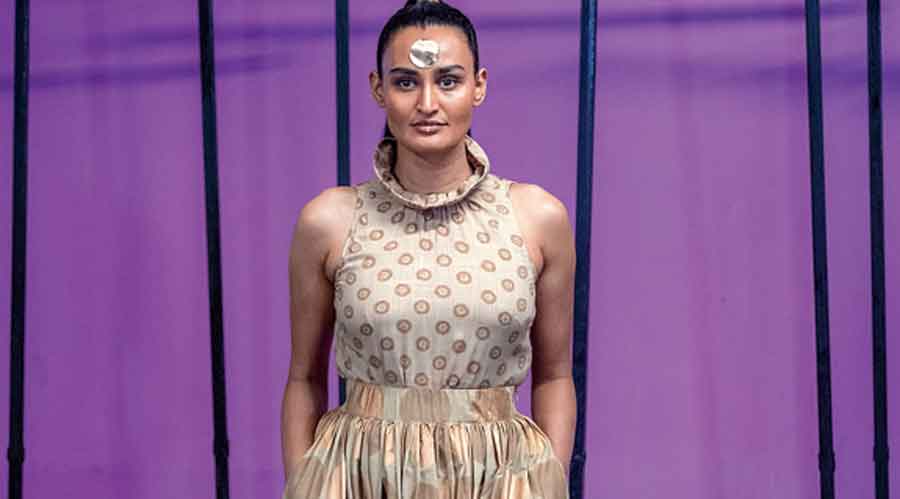
Picture courtesy: LFW
Any thoughts on addressing problems regarding supply chain, cost of raw materials, transport, accessibility and price points?
Handmade goods must eventually move up the value chain and provide a better wage for the maker. They cannot compete against mass-produced machine-made goods. And for this to happen, marketing and design can play a key role.
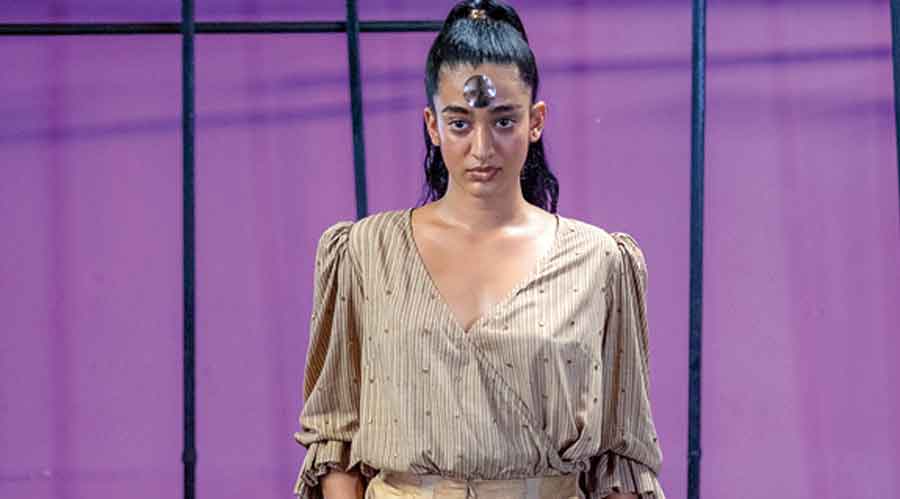
Picture courtesy: LFW
What is the key to balancing the business aspect of sustainable fashion according to you?
It can be balanced by creating sustainable products that are relevant to the marketplace and by ensuring that every aspect of the production and distribution processes respects the norms of sustainability.
How do you envisage sustainability in fashion in India in the next five years?
As per the reports, the handloom and handcraft sectors are still the largest employers after agriculture. One hopes that the policy planners acknowledge this and create support systems to allow this to continue. Private industry must participate, all the while ensuring that the returns to the makers are maximised.
Gaurang Shah
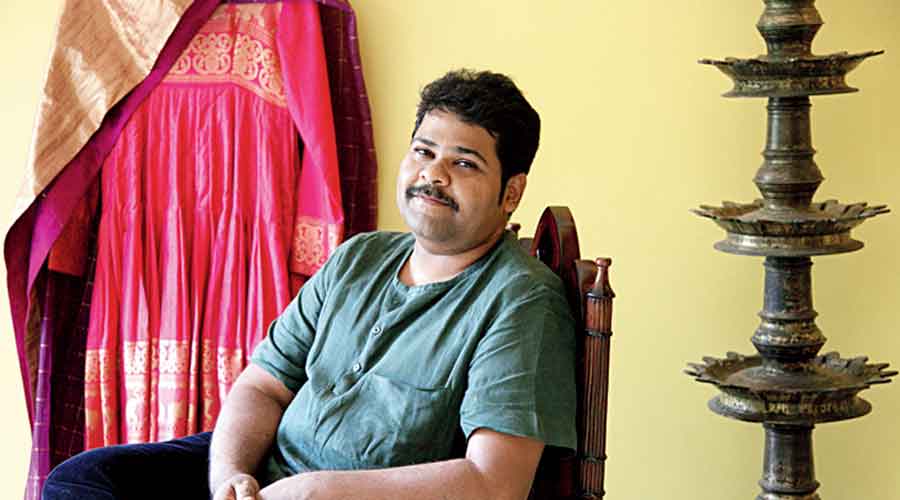
Gaurang Shah
Tell us about what you showcased at LFW and your inspiration behind it...
Taramati is an artisanal ode to the legendary courtesan of the seventh sultan of Golconda, Abdullah Qutb Shah — the ravishing Taramati. Transforming traditional designs into contemporary ones with our unique dramatic signature aesthetics — from the renewal of ikat, Kanchi, Patan, to the rediscovery of Kota, Kani, Uppada, Benarasi, Venkatgiri, Paithani in the laborious and complex format of Jamdani weaving, we have created many fascinating iterations in our Taramati sari collection.
What about sustainability are you most passionate about?
My passion is to continuously motivate Jamdani weavers. The contribution I have made over the years is to sustain them with inventive designs, giving them ways to learn artisanal diversity. I love the Indian sari and my dream is to consistently create exquisite saris that entice every woman on earth.
What is the biggest struggle you face while putting sustainability at the forefront in India?
The acceptance that handlooms have the grandeur and the style to make a fashion statement. For it to hold its fort, consumers must believe it is inventive, timeless and certainly is as versatile as other materials.
Any thoughts on addressing problems regarding supply chain, cost of raw materials, transport, accessibility and price points?
Every piece takes months to arrive from the looms, so the heart of our business is our Jamdani weavers and the heartening thing is the tribe is growing. For years, we have ensured the supply chain is sustainable and robust. So, problems don’t exist except moments when copycats threaten original work.
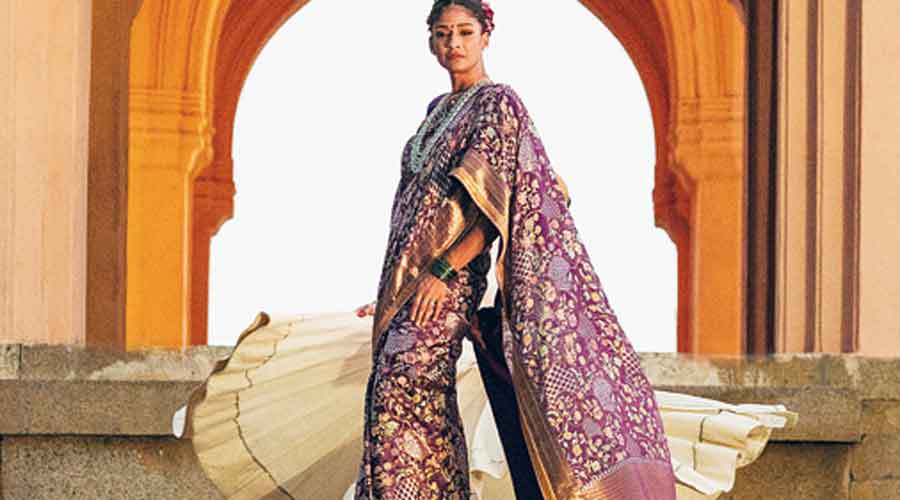
Picture courtesy: LFW
What is the key to balancing the business aspect of sustainable fashion according to you?
We need to create a robust mechanism from design to market. The weavers need motivation to continue their art and we provide them the stimulus with challenging new designs, innovations and creating demand.
How do you envisage sustainability in fashion in India in the next five years?
This is in the hands of consumers. Handlooms did find a challenging phase in history, but now, I am confident that it will only gain strength as we move forward.
Rajesg Pratap Singh
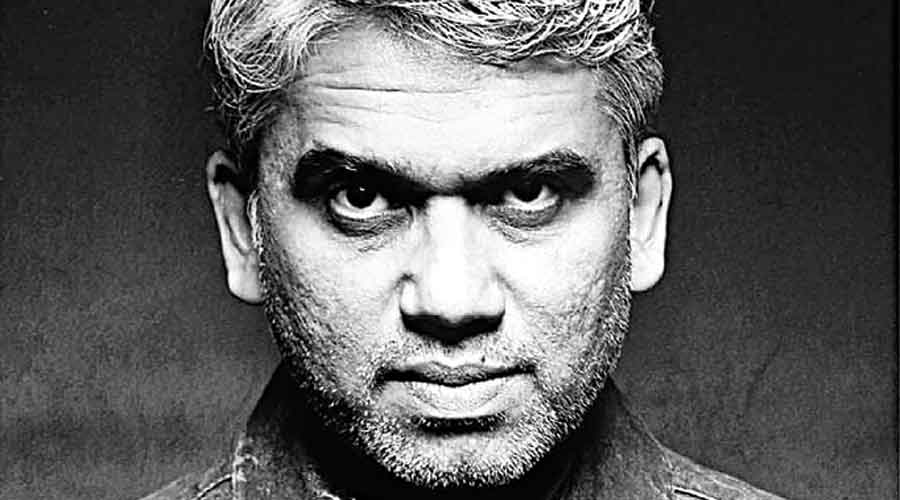
Rajesg Pratap Singh Picture courtesy: LFW
Tell us about what you showcased at LFW and your inspiration behind it...
We are showcasing an exclusive collection for Satya Paul of double ikat from the skilled artisans of Telangana and the idea is to work to promote Indian textiles. Our collection of ‘Mirroring Palla’ saris is as dual in its design as in its production and it is as graphic as it is gentle. Stark in its monochromes, blurred in its geometry, refined in its purity — simple cotton saris, reminiscent of a simpler world.
What about sustainability are you most passionate about?
The larger aim is to work with craft clusters and artisans across the country to generate jobs and preserve craftsmanship. However, as a brand
we are not in the business of revival. As an industry, we should best use the variables available and work with them to improve the quality of products coming out of India.

Picture courtesy: LFW
What is the biggest struggle you face while putting sustainability at the forefront in India?
Sustainability itself is a very complicated issue. Most people in India think that they’re in drab colours made from vegetable dyes and have a generally cheap vibe. But it’s far from the truth.

Picture courtesy: LFW
What is the key to balancing the business aspect of sustainable fashion according to you?
Sustainability is a human knowledge effort and, for me, it is how, as humans, we’re evolving. And I think that we are messing up. This whole drama about natural fabrics being sustainable or about technology being the vampire is not true. The fact is technology is telling you about the ability to harm. There needs to be a balanced and a very scientific approach to this. It can’t be fables and storytelling or half-baked truths.

Picture courtesy: LFW
How do you envisage sustainability in fashion in India in the next five years?
The fashion industry has actively been trying to incorporate sustainability as an important aspect for a while now. I only see this growing in the next five years. I’m involved in every step, from production to the final product and I’m constantly researching and learning.
Pankaj and Nidhi
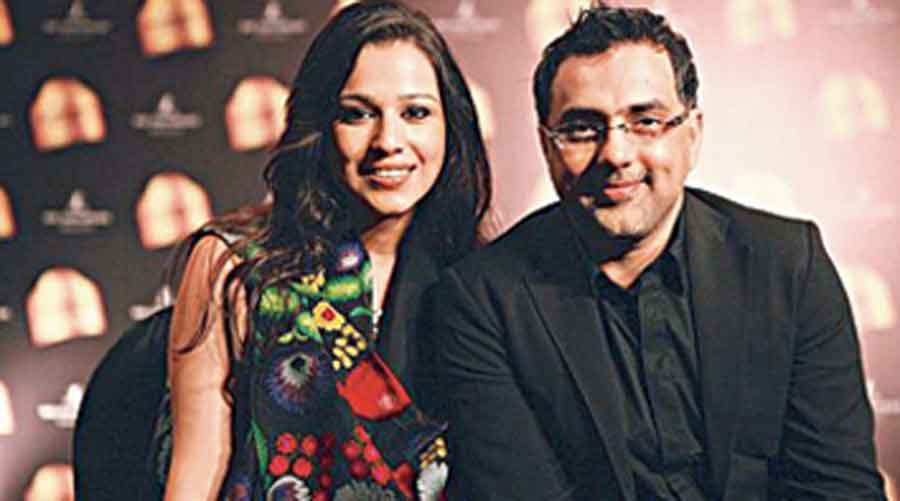
Pankaj and Nidhi
Tell us about what you showcased at LFW and your inspiration behind it...
This collection also marks our second collaboration with R-Elan, a brand that has showcased exceptional technological prowess and creates futuristic fabrics. Our collection is called Talisman and it metaphorically aims to transport the wearer into a transcendental state of absolute bliss. Positive deeds and actions, specifically when it comes to the environment and taking conscious steps towards a more sustainable future, is the driving philosophy of this collection.
What about sustainability are you most passionate about?
The idea of sustainability is a big part of our vision but there still is a long way to go. We are actively trying to minimise waste that is produced in the process of manufacturing. Our collaborations with R-Elan bring us one step closer to what we want to achieve. With them, we have discovered fabrics that have been made out of recycled plastic bottles and other waste products. It still feels surreal to acknowledge that what was once a discarded plastic bottle has now turned into this beautiful fabric that feels like a dream — soft and luxurious. It feels great knowing that we are contributing to the movement in our own way.
What is the biggest struggle you face while putting sustainability at the forefront in India?
Finding avenues that create fabric that are ethically and sustainably sourced is still an obstacle. However, we choose to perceive it as a joyous quest when we discover brands and materials that are sustainable.
Any thoughts on addressing problems regarding supply chain, cost of raw materials, transport, accessibility and price points?
Even before the pandemic, people were trying to control the costs that are involved in the mentioned processes. But I feel that the situation has allowed us to revisit and reconfigure our perspective and introduced a novel sense of calm to introspect and examine supply-chain processes. It brought attention to over-consumption and the production of a substantial amount of waste.
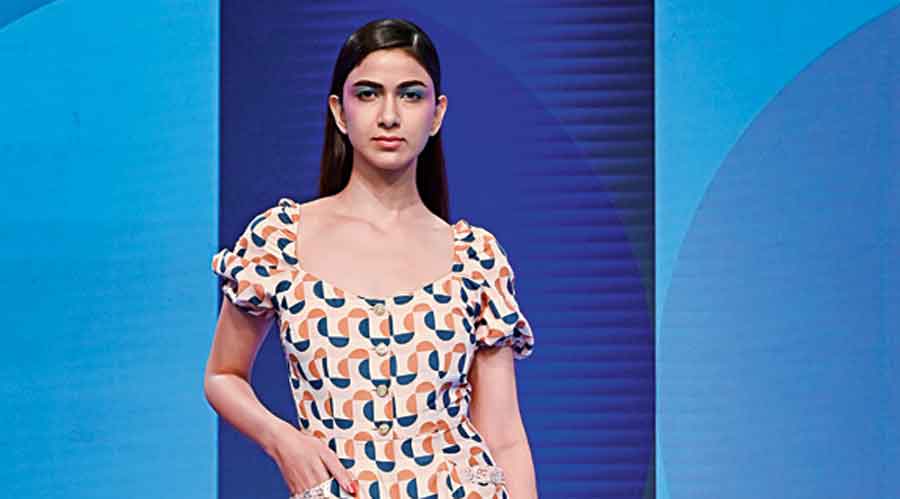
Picture courtesy: LFW
What is the key to balancing the business aspect of sustainable fashion according to you?
In the fashion industry, it has been the norm to showcase everything within the brand’s capacity without realising the toll it takes on the environment. The pandemic allowed us to take a step back and create a controlled collection while actively reducing our environmental footprint. We have been forced to reduce the quantity of production, which has worked out for the best and we endeavour to continue with this practice for as long as we can.
How do you envisage sustainability in fashion in India in the next five years?
Sustainability as an idea is an all-encompassing one and still needs a lot of nurturing, awareness and support. It will be a gradual process that cannot be achieved in a short span — especially if one wants it to be a long-term goal. The fashion industry has come a long way when it comes to creating ethical and environmentally conscious garments.
Anavila Misra

Anavila Misra
Tell us about what you showcased at LFW and your inspiration behind it...
We are showcasing our festival collection, Dhanak. The collection plays with beautiful jewel tones and we have worked with Khatwa craft for embellishments on our linens. Sequins and zari add sheen and the kaftan fit has been used extensively.
What about sustainability are you most passionate about?
I am passionate about the whole value chain of creating mindful products. Creating sustainable employment is something that really inspires me.
What is the biggest struggle you face while putting sustainability at the forefront in India?
The ancient Indian lifestyle is based on the principles of sustainability and balance. I feel our customers really understand that value and we are able to move forward on our path due to their support. We are constantly striving to practise sustainability in our daily work. I don’t feel it’s a challenge but surely a constant effort.
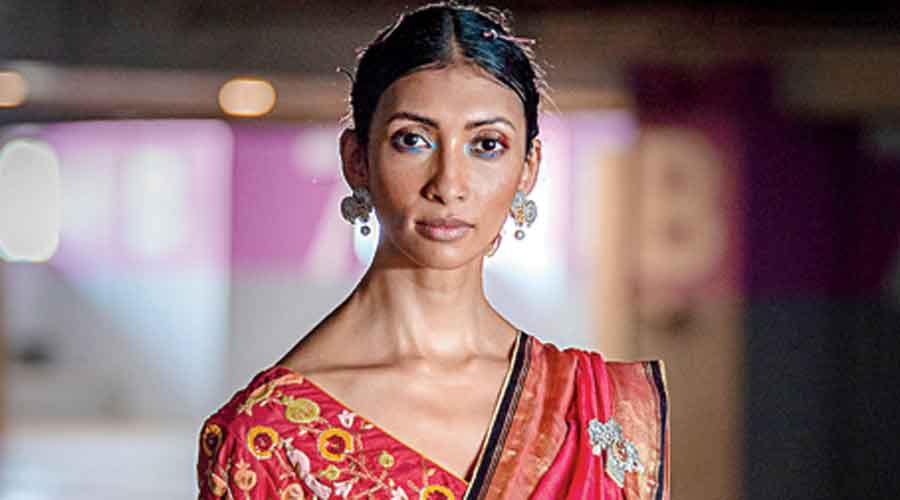
Picture courtesy: LFW
Any thoughts on addressing problems regarding supply chain, cost of raw materials, transport, accessibility and price points?
Now, it’s very important to rephrase how we have worked in the past, plan better, look at solutions for issues around raw material accessibility and more with the artisans. It’s also a time to go back to the drawing board, look at the broader picture and innovate.
What is the key to balancing the business aspect of sustainable fashion according to you?
Understanding your clients, communicating with them regularly and innovation is the key to balancing the business aspect.
How do you envisage sustainability in fashion in India in the next five years?
There has been a rise in awareness of both the consumers and the creators around sustainable practices. We, as a nation, have also gone back to our core strength of textiles and crafts in a huge way and I only see a brighter future.
Urvashi Kaur
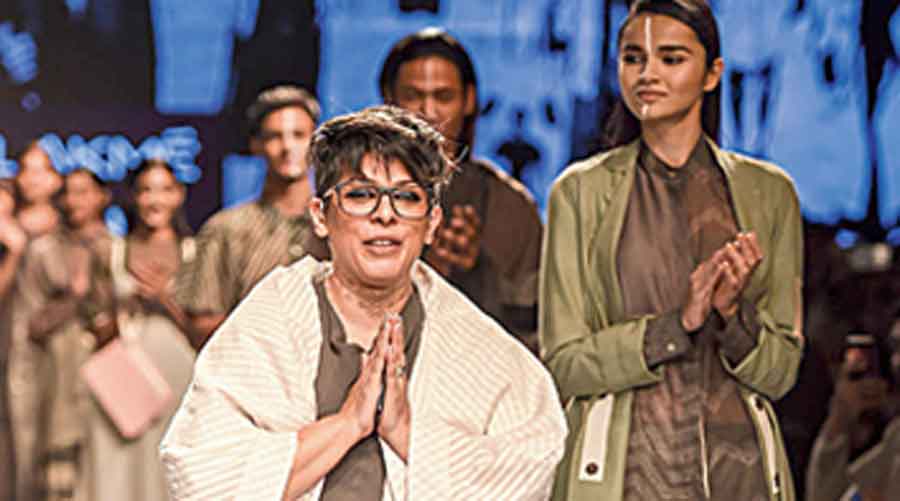
Urvashi Kaur Picture courtesy: LFW
Tell us about what you showcased at LFW and your inspiration behind it...
The collection brings the concept of transformation to life, seeking to move forward with its focus on constant change and renewal. I have used a craft that has been an integral part of my work — shibori tie-dye. With the help of skilled artisans, we’ve created unique patterns by manipulating the textile through the process of tying, folding and pleating and have then interpreted it in my minimalist aesthetic, using unexpected strategic placements and muted shades.
What about sustainability are you most passionate about?
As a label, we have always created collections that are trans-seasonal. We encourage the end consumers to buy pieces that are timeless, handcrafted and versatile. We see the concept of season-less collections as a major step towards fixing the problem of overproduction and wastage.
What is the biggest struggle you face while putting sustainability at the forefront in India?
The processes that we have built into the business of fashion are deeply flawed. One of the biggest struggles for us around the challenges of being sustainable is competing with the fast speed of production and cheap value of the products that people have been conditioned to. Especially in times like this, changing the system and mass consumer mindset is going to be difficult. But there is also a silver lining that discussions around healthier practices has started spreading its root.
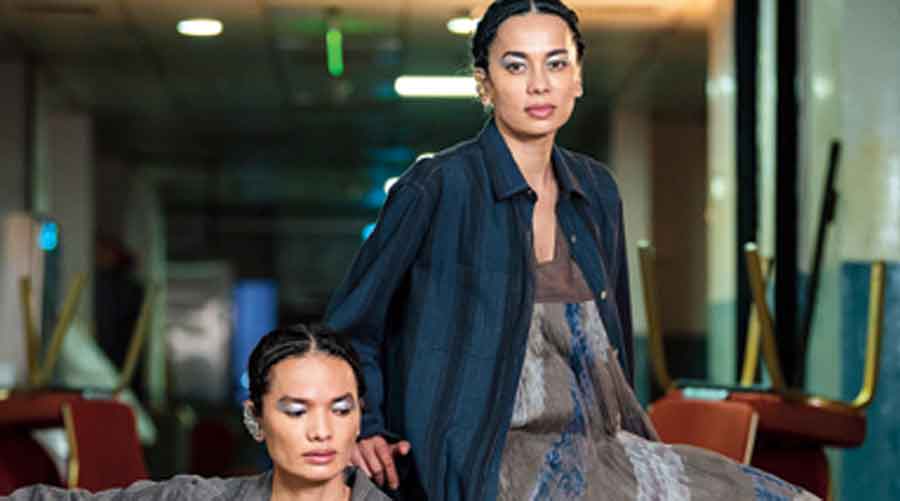
Picture courtesy: LFW
Any thoughts on addressing problems regarding supply chain, cost of raw materials, transport, accessibility and price points?
The label works with diverse interdependent artisanal supply chains that are vast and complex. The situation currently has created major obstacles but at the moment, we are trying to ensure that the basics are in place. Brands need to support the fragile artisanal ecosystem by upholding their commitments. In these conditions, it is imperative to not transfer the liability to the craftspeople. As far as price points are concerned, we work with separates largely, so price-sensitive customers have options.
What is the key to balancing the business aspect of sustainable fashion according to you?
It is imperative to place definite importance on value, to raise awareness and help change buying patterns as there is a great cost involved when we talk about a product that has more human input and has been created in a slower, more conscious way. Working with retailers that understand this along with initiatives dispersed through media have led to a growing awareness.
How do you envisage sustainability in fashion in India in the next five years?
We have vast, rich resources of textiles and craftsmanship. Ethical fashion is now recognised as a mainstream feature and I hope this leads the fashion businesses to shift focus to nurturing their supply chains and human capital. I’m optimistic that we will course-correct and come out of this catastrophe as a wiser industry.

